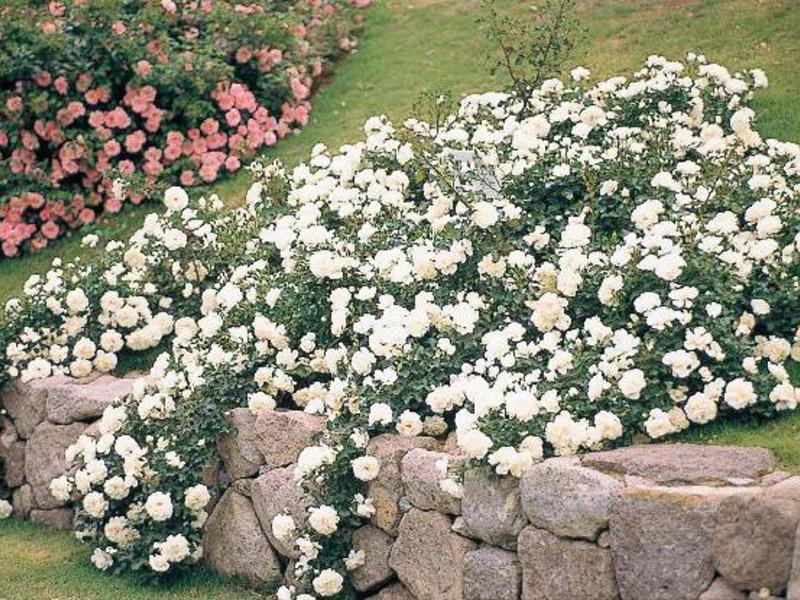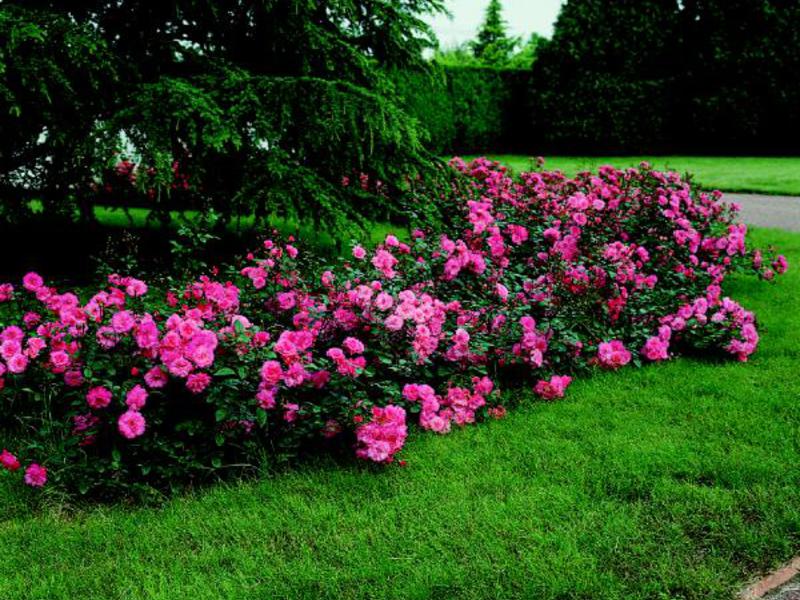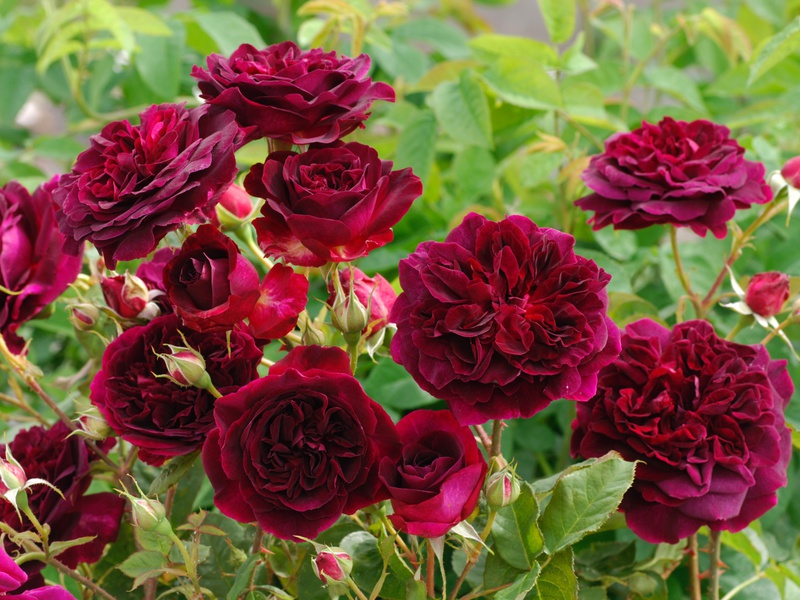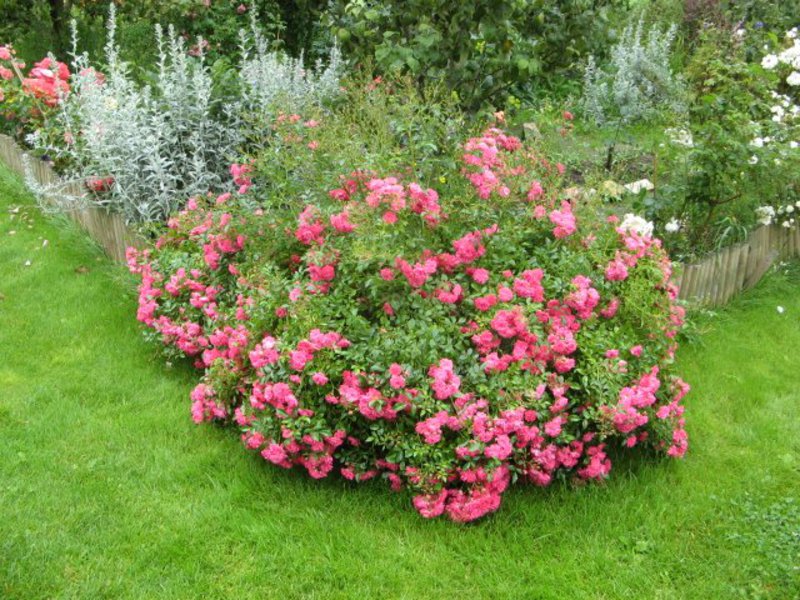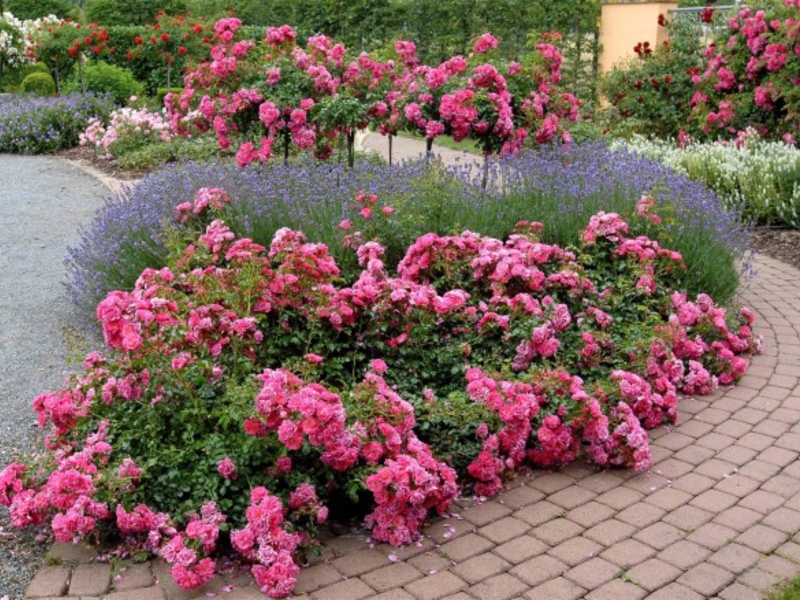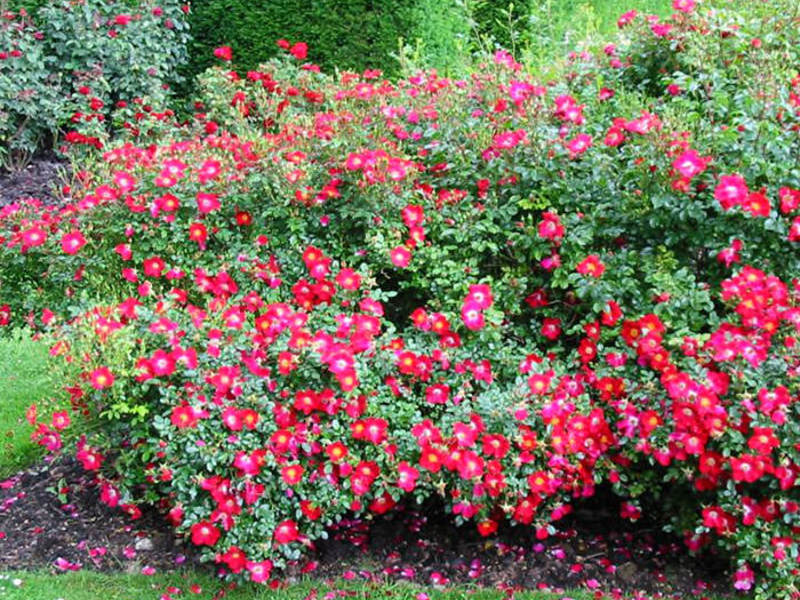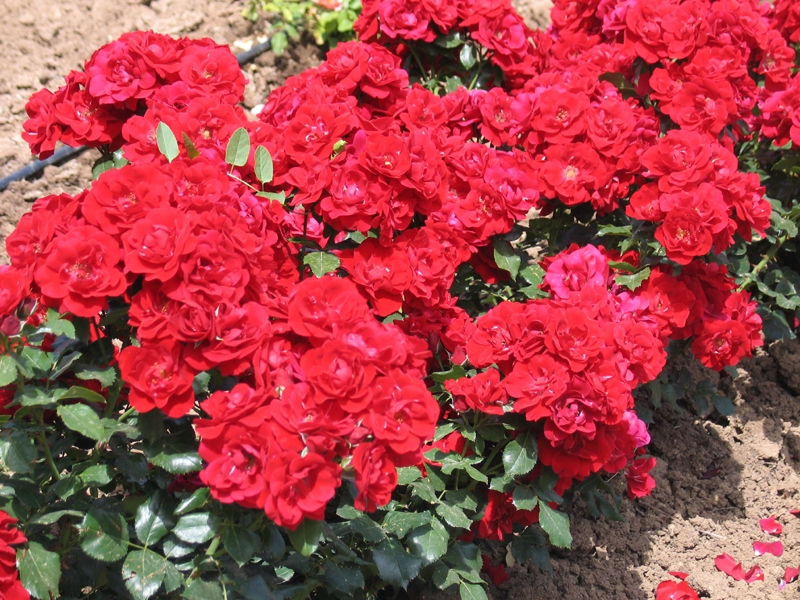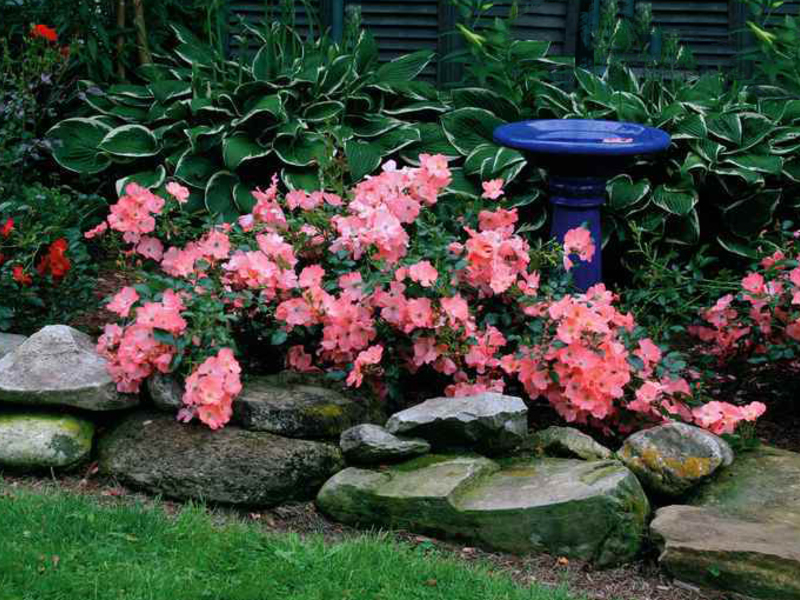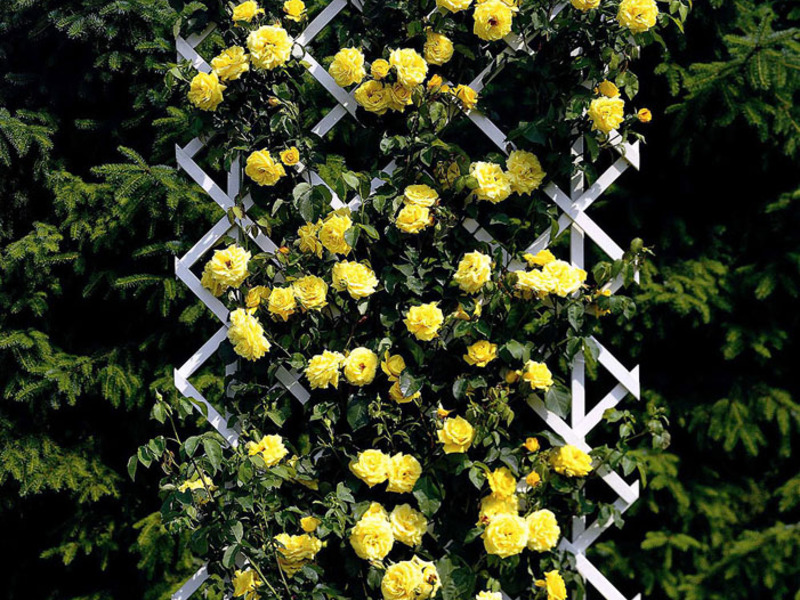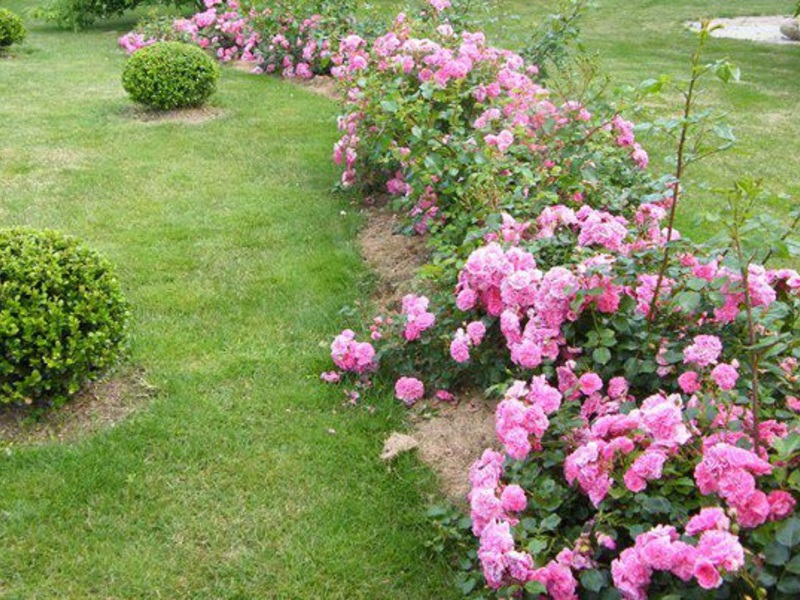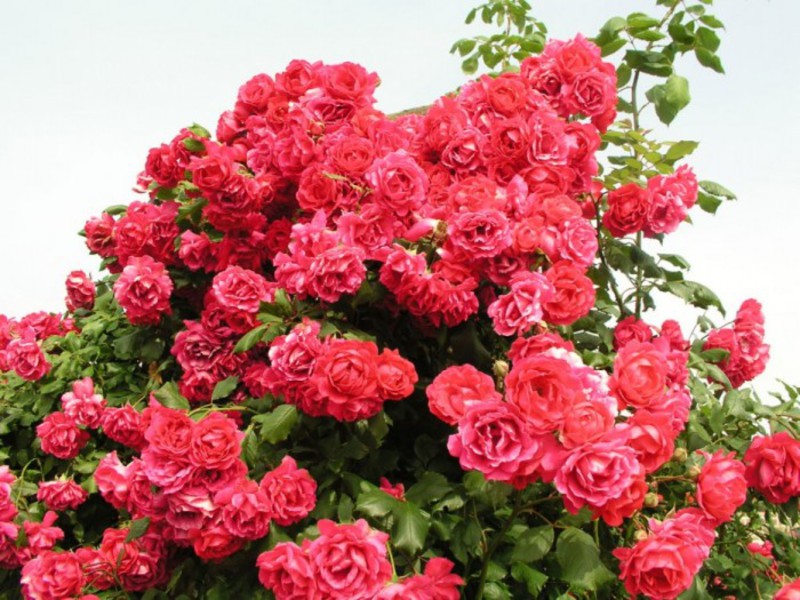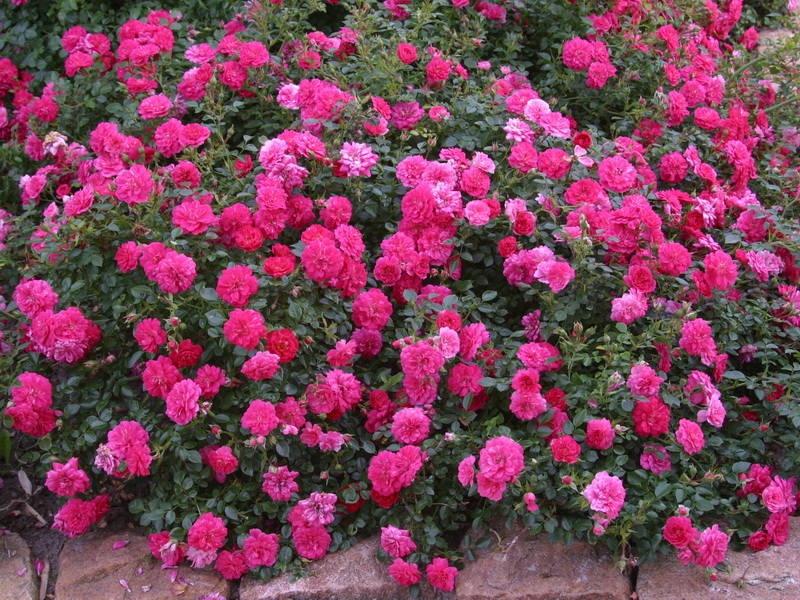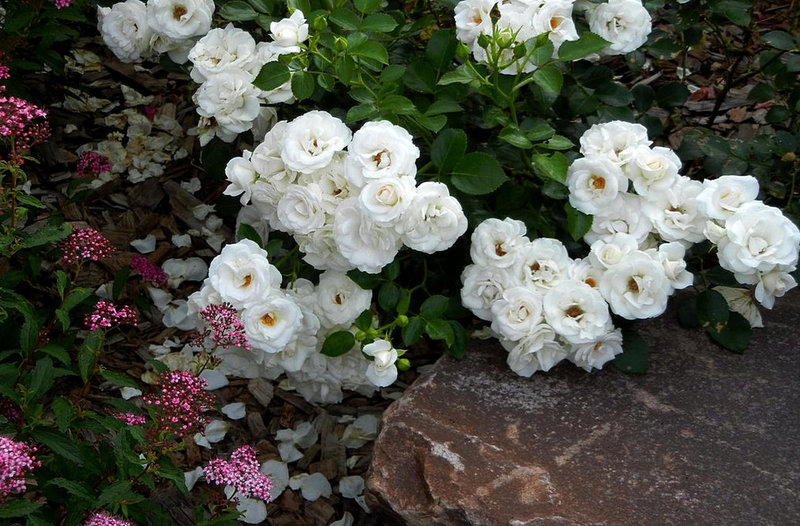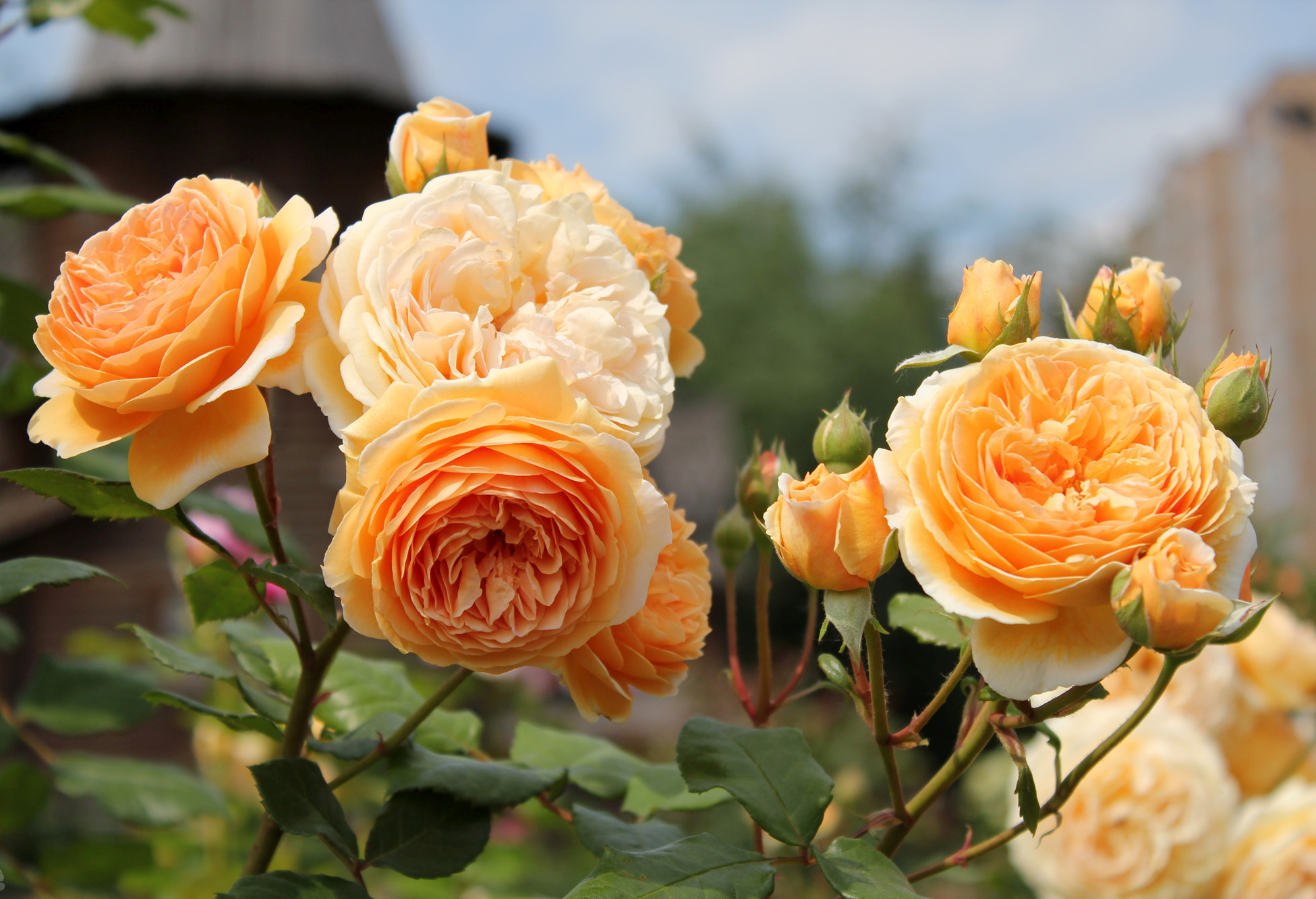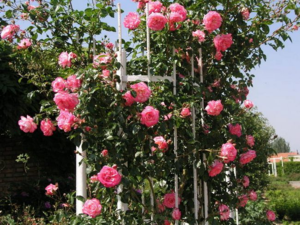Ground cover roses refer to the broadest and ever-increasing range of low-growing shrub roses, from dwarf, branchy, erect bushes to forms that creep along the ground. Particularly popular are the "wide-growing" varieties, which, although bushy, can be grown in pots, vases and hanging baskets.
Content
Ocean of different roses
A huge number of numerous and varied varieties of ground cover roses are characterized by long and abundant flowering periodas well as increased resistance to disease. Among this variety, you can choose types for the following design techniques:
- classic decorative landscaping of small surfaces and mounds;
- constructions of colorful borders and hedges;
- decoration with color spots of mixed perennial flower beds;
- decorating gazebos, terraces, patios, balconies and other architectural forms.
Not yet approved, but already proposed by German breeders, the official international classification of ground cover roses. The term "ground cover" is proposed to be replaced by "low-growing shrub" and introduce the next gradation, which is based on differences in the height of the bush and the type of growth of its shoots:
 Bushes with long creeping shoots.
Bushes with long creeping shoots.- Roses with arched flowing stems.
- Broadly branching creeping bushes.
- Low, upright shrubs with a wide scattering halo.
- Small, compact bushes with short creeping shoots.
Proven German scenery
Amber sun (Amber Sun, 2005). A versatile, broadly branched shrub with cascading shoots, for mixed flower beds, borders, tall street vases and hanging baskets. It is valued for its unusual color: young flowers and buds are copper-yellow, and closer to wilting, they brighten to a creamy yellow color.
Eskimo (Eskimo, 2006). Ideal for green and white hedges - grows more in height (up to 0.8 m) than in width. Easy to care for - the flowers are self-cleaning, and the branches do not need pruning. White simple flowers are collected in clusters of 8 pieces.
Stadt rom (Stadt Rohm, 2007). Winner of numerous awards at international exhibitions. The undersized half-meter bushes are covered with a huge number of brushes with simple, pink flowers of a pastel-salmon shade that do not fade even in strong sun.
Candia Meidiland (Candia. Meidiland, 2007) The cultivar fell in love with its special three-color color of non-double flowers. The underside of the petals is white, the petals on top are bright red, scarlet, and the middle is painted yellow and covered with a large number of "curly" stamens.
Larissa (Larissa, 2008). A bush with arched, falling branches up to 1 m long and a huge number of traditional pink double flowers, self-cleaning and collected in a brush.
Lavender Meidiland (Lavender Maidiland, 2008). The variety is intended for cultivation in flowerpots and tubs.Simple flowers of pink color with lavender tint are collected in small clusters. It is especially attractive for its color fastness and subtle, unusual smell and aroma.
Jazz (Jazz, 2008). An upright, spreading, self-cleaning bush grows up to a maximum of 70 cm. The variety is liked for its unusual multi-colored flowers - each flower has its own shade - peach, yellow, copper, orange, golden. Bush
Pretty star (Preti Star, 2008) Another upright bush (0.8 m), continuous flowering with exotic medium-sized flowers. The acid-lemon yellow color looks great against the background of small, dark green, almost black foliage.
Solera (Solero, 2009) German breakthrough breeding for breeding rose bushes with special protective properties against diseases. Widely growing shrub with branches up to 0.7 m long. Cup-shaped double single flowers are painted in bright yellow lemon shades.
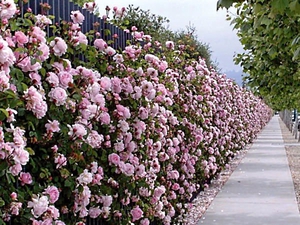 Lipstick (Lipstick, 2011). The variety perfectly resists all diseases affecting foliage. The color of semi-double flowers is unusual: the lower part is painted white, and the upper part is an intense purple-carmine color with a pink tint. The bush is spreading, with an arcuate drop of meter-long branches. The aroma is rose hips, with a thin trail of tea rose aftertaste.
Lipstick (Lipstick, 2011). The variety perfectly resists all diseases affecting foliage. The color of semi-double flowers is unusual: the lower part is painted white, and the upper part is an intense purple-carmine color with a pink tint. The bush is spreading, with an arcuate drop of meter-long branches. The aroma is rose hips, with a thin trail of tea rose aftertaste.
Residenz (Residentz, 2012). A unique rose that perfectly resists all types of diseases and easily tolerates drought or heavy rains. It is also valued for its extended flowering period and decorative effect of flowers - the petals of semi-double racepal inflorescences are painted in intense carmine color, with a contrasting light pink center.
Matador (Matador, 2012). Disease-resistant selection of self-cleaning compact (0.5 m) bushes of scarlet semi-double carpal roses. It is valued for its unusually early flowering.
Fashionable imitation of the legendary "Englishwomen"
One of the most famous breeders of ground cover roses is the Englishman David Austin. Its collection is so wide that it demanded to introduce subgroups for the name catalog of hybrids: 1) old, 2) musky, 3) selection of a white rose, 4) "Leander".
Of course, his work has found a lot of fans and imitators in many countries around the world. Today, the following replicas of his famous hybrids are recognized as ground cover queens among flower queens. Here are their names.
Appleblossom Flower Carpet... Pale pink German mutation of the original English crimson original Flower Carpet. The bushes are particularly hardy and highly resistant to various diseases.
Generosa... A popular imitation hybrid from the French nursery Guillot. This version is characterized by a very intense, delicious aroma, increased vitality and minimal maintenance.
Knock out... A hybrid from the United States, which is rightfully considered a triumph of modern breeding - it is so unpretentious that it will grow on any soils and areas, regardless of lighting, and in terms of winter hardiness and resistance to diseases, it has no equal.
World celebrities
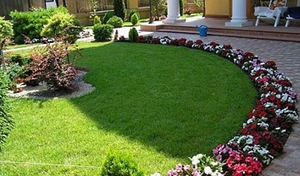 Scabrosa... A hybrid of rose and rugosa by maestro Robert Holmes. Purple flowers - non-double, slightly wrinkled, up to 9 cm in size. Extremely unpretentious and viable shrub (up to 1 m), requiring no maintenance. It blooms several times during the season. The resulting fruits are extremely decorative, do not require removal - they resemble medium-sized tomatoes. Cut flowers do not last long. Unlike fruits, which will be a great decoration for dried flowers.
Scabrosa... A hybrid of rose and rugosa by maestro Robert Holmes. Purple flowers - non-double, slightly wrinkled, up to 9 cm in size. Extremely unpretentious and viable shrub (up to 1 m), requiring no maintenance. It blooms several times during the season. The resulting fruits are extremely decorative, do not require removal - they resemble medium-sized tomatoes. Cut flowers do not last long. Unlike fruits, which will be a great decoration for dried flowers.
Rosa Schoener’s nutkana... The original flower shape (up to 9 cm) from the American Georg Schenser. Rose petals and fluffy yellow center are located on stems (1.5 m) without thorns. Numerous petals will open until a kind of dense disc forms. When pruned correctly, ball-shaped bushes look great next to plants whose foliage will be intensely colored in the fall. Withstands frosts down to -20 ° C.
Sophy's Rose... English breeding, 1997.Delightful round compact bushes of scarlet roses, re-blooming. Look gorgeous on decorative beds with herbs, mixboards or in tubs. They have a subtle pink scent and are suitable for allergy sufferers. Flowers - double, with 80 petals forming a rosette up to 7 cm. The variety is relatively winter-hardy: up to -12 ° C.
Features of growing ground cover roses
Shrub ground cover roses are very unassuming and do not require special attention.
Landing
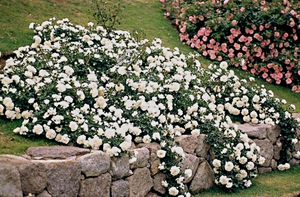 In this matter, ground cover pink shrubs decided to stand out among their congeners - before planting, the soil is not prepared in a hole for a new bush, but over the entire area that they theoretically will occupy during growth. The digging depth of such a site is 0.7 m, with the obligatory removal of all extraneous root systems and weeds. After planting the bush, the entire site is carefully mulched. The depth of the trenches or pits for planting - depends on the length of the root system of the seedling + 10 cm.
In this matter, ground cover pink shrubs decided to stand out among their congeners - before planting, the soil is not prepared in a hole for a new bush, but over the entire area that they theoretically will occupy during growth. The digging depth of such a site is 0.7 m, with the obligatory removal of all extraneous root systems and weeds. After planting the bush, the entire site is carefully mulched. The depth of the trenches or pits for planting - depends on the length of the root system of the seedling + 10 cm.
In regions with harsh winters, it is preferable to plant roses in early spring, and for areas with warmer climates - in autumn.
Care
Weeding and fertilizing annually are all the chores. In hot, dry weather, plentiful individual watering is necessary - once a week, 15 liters of warm water for each old bush and 2 times a week for young seedlings. It is necessary to feed with complex fertilizers 3 times:
- 2 weeks after the first foliage appears.
- After the end of the first wave of flowering.
- In the fall - only potash fertilizers.
Before winter, depending on the variety, it is better to cover some varieties of bushes with a special material, laid on a low frame or spruce branches. Any variety of ground cover roses can be propagated independently using the spring technique of layering or cuttings.
Pruning
Groundcover rose bushes trimmed as needed and depending on the variety. Pruning is carried out in order to stimulate tillering or to maintain good condition. Shoots growing inward must be thinned out.
Slices are performed 0.5 cm above the external buds and disinfected with garden varnish. After pruning, supportive therapy is desirable - a single spraying with preparations containing copper.
Rejuvenation of the bushes is carried out 1 time in 4-6 years - in the fall, absolutely all branches of the bush are subject to very short pruning.
Landscaping techniques
 It is difficult to imagine a modern landscape design that would do without the use of ground cover roses. In addition to a special, aristocratic decorative effect, such roses can also perform a functional load - strengthen the topsoil, thereby preventing soil leaching during floods in areas with hilly relief.
It is difficult to imagine a modern landscape design that would do without the use of ground cover roses. In addition to a special, aristocratic decorative effect, such roses can also perform a functional load - strengthen the topsoil, thereby preventing soil leaching during floods in areas with hilly relief.
When designing a decorative site, it is worth remembering the most respectable neighbors for ground cover roses:
- the lower tier of the planting - wormwood, santolina, silver sage, geranium, cuff, iris, herbs, ornamental onions;
- the middle tier of planting - dahlias, delphinium, hosta, foxglove, aerial cereals.
The latest squeak of fashion in landscape design, lasting for several seasons, is the neighborhood of ground cover roses and clematis.
The design from "living curbs" looks great in combination with monumental bouquets in garden vases.
Carpet-weaving varieties will be great decorating flowerpots or flowerpots.
A well-thought-out design is not only a decoration of the front space with compact shrubby roses, but also filling the premises with a wonderful pink scent.
Popular varieties for Russia, Belarus and Ukraine
All of the above in this article, varieties of ground cover roses feel great in our climatic conditions.Below we list the name of the varieties that are most popular, good planting survival rate, high winter hardiness, disease resistance, unpretentious care, seedlings of which are easy can be bought in stores and nurseries:
 whites - Aspirin, Pearl Meyandecor, Sunny, Castelruther Spatzen, Snow Ballet, Sveny. Ivery Drift
whites - Aspirin, Pearl Meyandecor, Sunny, Castelruther Spatzen, Snow Ballet, Sveny. Ivery Drift- yellow - Sonnenshirm, Annie Dupre, Nadia Meijandecor, Vacations, Augusta Louise (with orange border);
- pink - Penny, Palmengarten Frankfurt, Fairy, Lovely Fairy, Crazy, Rosita, Four seasons, Topolina, Bayernland Carpet;
- orange - Paul Cezanne (bush floribunda), Ethiopia, Fency, Apricot Clementine; Ninette;
- peach, cream - Pat de valur,
- red - Hello, Alpengluchen, Scarlet Meijandecor, Rouge Meijandecor, Cherry Girl, Meidy (with white lining), Rodi; Nostalgia.
- crimson and purple - Pearl Hayes, Purple Rhine, Red Fairy, Prodzhe Ecarlat. Tornado.
Having made a choice in favor of ground cover roses, you are guaranteed to free yourself from unnecessary care and become the owner of regal bushes that bloom intensively throughout the summer.
